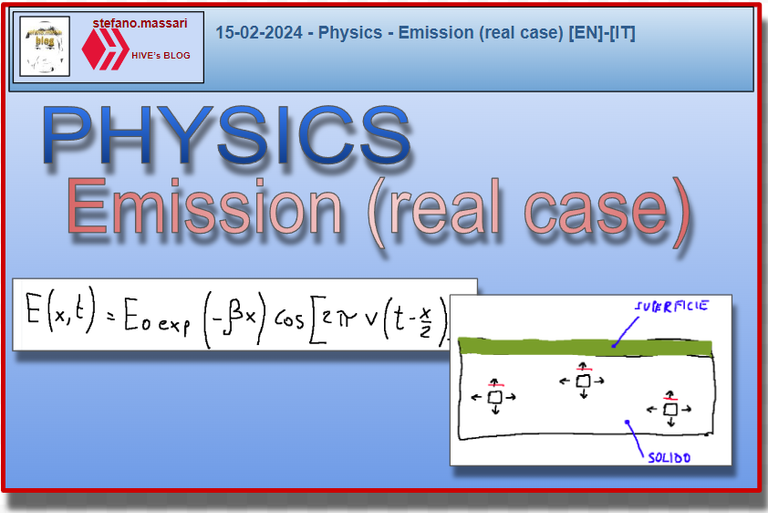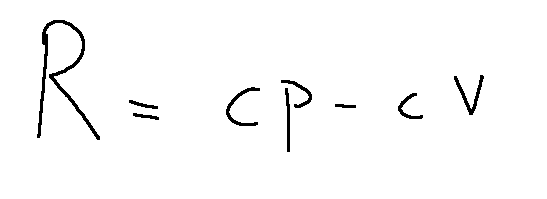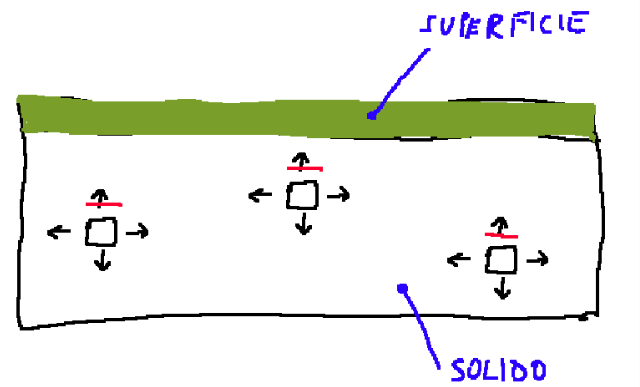15-02-2024 - Physics - Emission (real case) [EN]-[IT]

~~~ La versione in italiano inizia subito dopo la versione in inglese ~~~
ENGLISH
15-02-2024 - Physics - Emission (real case) [EN]-[IT]
Basic concepts
When we approach thermodynamics there are some basic concepts to always keep in mind.
One of those things is Mayer's relationship.
In the meantime, we present it below:

Where:
cp = molar specific heat at constant pressure
cv = molar specific heat at constant volume
Mayer's relation establishes that for a thermodynamic transformation at constant volume the molar specific heat cv is generally lower than that at constant pressure cp.
From Mayer's relation it follows that at constant pressure it is necessary to supply more heat to vary the temperature of a mole of gas by 1 °K, because part of the heat supplied is used by the gas to do work by varying its volume.
Emission (real case)
Exposition of the law for emission with dissipation in real case.
Let's consider a wall that oscillates and therefore emits waves. So we are in the case study of the radiation and transfer of energy between two bodies by means of electromagnetic waves.
Starting from the ideal case, emission without dissipation, we have the following formula

to the ideal case we must add an important element the attenuation coefficient (β)
The emission formula with dissipation in the real case would become the following

To understand the progress of a wave in the case of thermal energy radiation, i.e. in the case of thermal radiation, it is necessary to know the values of the refractive index β
After seeing the figure below we can make some considerations.

We place our eyes on the surface (green rectangle). to stop an electromagnetic wave, a very thin plate is enough, even a few microns, while if our barrier to stop the electromagnetic wave was made of gas, it would need a thickness of km.
Another consideration to make is that an electromagnetic wave emitted in solids (in the figure represented by black squares, small volumes) stops a few microns away.
In the case of the figure proposed above we can say that the total emission is given only by the thin layer of a few microns thick which is found just below the surface (in the figure the surface is represented by the green rectangle). This very thin layer is called the emitting surface.
Conclusions
In a painted aluminum wall it is the layer of paint on the wall that emits energy and not the wall as such.
Request
Have you ever studied or read something about electromagnetic waves?

15-02-2024 - Fisica - Emissione (caso reale) [EN]-[IT]
Concetti base
Quando ci avviciniamo alla termodinamica ci sono alcuni concetti base da tenere sempre in mente.
Una di queste cose è la relazione di Mayer.
Intanto la presentiamo qui sotto:

Dove:
cp = calore specifico molare a pressione costante
cv = calore specifico molare a volume costante
La relazione di Mayer stabilisce che per una trasformazione termodinamica a volume costante il calore specifico molare cv è in generale minore di quello a pressione costante cp.
Dalla relazione di Mayer scaturisce che a pressione costante è necessario fornire più calore per far variare di 1 °K la temperatura di una mole di gas, perché parte del calore fornito viene usato dal gas per compiere lavoro facendo variare il proprio volume.
Emissione (caso reale)
Esposizione della legge per di emissione con dissipazione in caso reale.
Consideriamo una parete che oscilla e che quindi emette onde. Quindi siamo nel caso di studio dell’irraggiamento e del trasferimento di energia tra due corpi per mezzo di onde elettromagnetiche.
Partendo dal caso ideale, emissione senza dissipazione, abbiamo la seguente formula

al caso ideale dobbiamo aggiungere un elemento importante il coefficiente di attenuazione (β)
La formula di emissione con dissipazione nel caso reale diventerebbe la seguente

Per comprendere l’andamento di un'onda nel caso dell'irraggiamento di energia termica, cioè nel caso di irraggiamento termico occorre conoscere i valori dell’indice di rifrazione β
Dopo aver visto la figura qui sotto possiamo fare alcune considerazioni.

Posiamo i nostri occhi sulla superficie (rettangolo verde). per fermare una onda elettromagnetica basta una lastra molto sottile, anche pochi micron, mentre se la nostra barriera per fermare l’onda elettromagnetica fosse fatta di gas, ci vorrebbe uno spessore di km.
Altra considerazione da fare è che un'onda elettromagnetica emessa nei solidi (in figura rappresentati dai quadrati neri, volumetti) si ferma a pochi micron di distanza.
Nel caso della figura sopra proposta possiamo dire che l’emissione totale è data solo dal sottile strato di pochi micron di spessore che si trova appena sotto la superficie (nella figura la superficie è rappresentata dal rettangolo verde). Questo sottilissimo strato viene chiamato superficie emettitrice.
Conclusioni
In una parete di alluminio verniciata è lo strato di vernice che è sulla parete ad emettere energia e non la parete in quanto tale.
Domanda
Avete mai studiato o letto qualcosa a riguardo delle onde elettromagnetiche?
THE END
I so much can remember this formula. Pretty straightforward to understand. Thank you for explaining
From this article we can learn by which law the amplitude of the waves emitted with dissipation by an oscillating wall varies and it is the following.

A very complex formula in my opinion. Nor is it easy to learn it by heart.
This formula was quite difficult for me to cram back then, lol
Thanks for the class
Thanks for your support. Here we begin to enter a complex field, that is, understanding what are the laws that regulate the amplitude of the waves emitted.
Below are the two main cases written in the form of a question.
By what law does the amplitude of the waves emitted without dissipation by an oscillating wall vary?
By what law does the amplitude of the waves emitted with dissipation by an oscillating wall vary?
Cp always goes a long way in helping us to understand the concept about heat transfer
Understanding the laws that govern the amplitude of the waves emitted during heat emission is quite complicated.
We can summarize the discussion in the two main laws:
The law by which the amplitude of the waves emitted without dissipation by an oscillating wall varies (the one written in blue).
The law by which the amplitude of the waves emitted with dissipation by an oscillating wall varies (the one written in black).
L'argomento è interessante ma non l'ho mai studiato.
Senza entrare nei dettagli, ammetto che io ho capito l'importanza dell'elettromagnetismo più o meno dopo i 40 anni.. non andavo già più a scuola da molto tempo